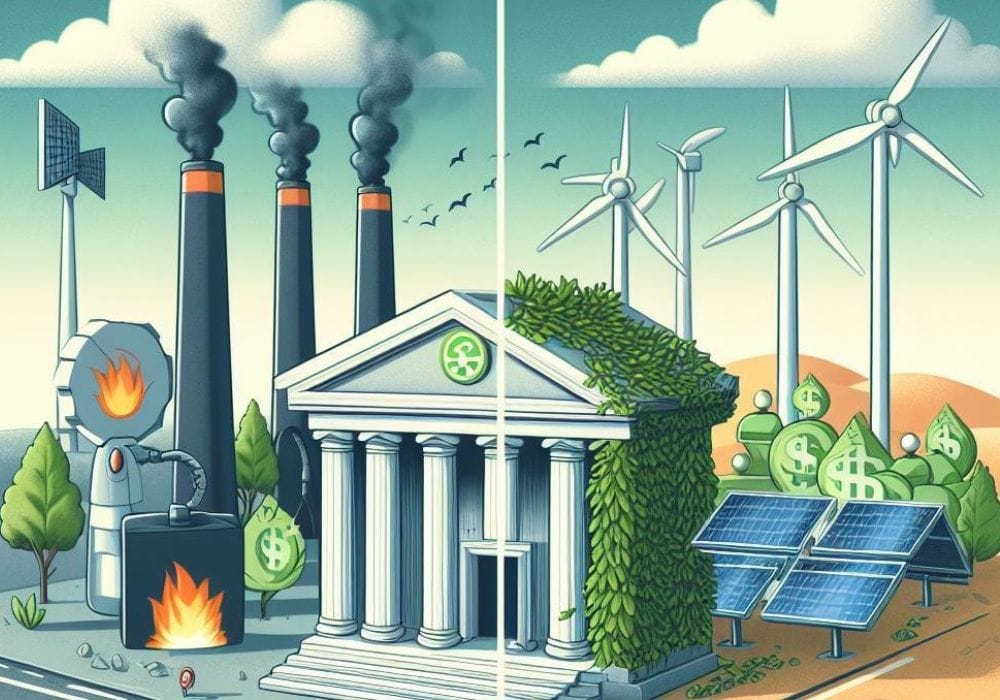Temperature records were broken month after month in 2023, pushing governments around the globe to promise to triple their renewable-energy capacity and transition away from fossil fuels at this year’s UN climate summit.
Yet despite these pledges, banks and other financial institutions – sectors crucial to funding the low-carbon transition – stood by their traditional borrowers and investees in the fossil fuel business. The last 12 months have revealed a growing standoff between governments, civil society organizations and climate scientists on one hand, and the oil and gas industry and their partners in the financial sector on the other.
Several years ago, the oil and gas industry at least paid lip service to the need to become net-zero by 2050. Now even that sentiment is disappearing, as the industry explores new and large fossil fuel projects while promising to reduce its process emissions (although not final emissions) through the untested technology of carbon capture.
In the meantime, the mainstream financial industry has become a silent cheerleader, continuing and sometimes increasing its exposure to the oil and gas industry to reap investment gains and fees from the continued flow of fossil fuels.
Here’s a review of how the banking and investment industries journeyed through this global impasse in the last year – and some predictions for how those trends will shape 2024.
Banks, asset managers and pension funds missing in climate action
At COP28, the UN climate summit in Dubai in December, environmentalists praised an agreement to triple renewable-energy capacity and transition away from fossil fuels, although it fell short of a hoped-for fossil fuel phaseout.
Yet only days after this agreement, BloombergNEF reported that there has been no recent progress by the world’s largest banks in financing the energy transition.
The so-called energy-supply banking ratio (ESBR) – the measure of financing for renewable energy relative to coal, oil and gas – was 0.73 to 1 at the end of 2022, slightly less than the ratio of 0.75 to 1 in 2021. The banks’ performance on this measure is a far cry from the ratio of 4 to 1 that BloombergNEF estimates is needed by 2030 to avoid global warming of more than 1.5°C.
Regionally, banks in Canada, the U.S. and Mexico had an ESBR ratio of 0.5 to 1, while European banks had a much better ratio of 2.8 to 1.
In the asset management industry, progress on the climate transition worsened. According to an analysis of 13,000 equity funds by InfluenceMap, the percentage of managers practising effective climate stewardship shrank from 33% in 2021 to only 18% in 2022.
Even ESG-labelled funds (which take into consideration environmental, social and governance factors) in Europe increased their oil and gas exposure. Bloomberg reported that Article 8 funds – funds that promote ESG goals in general as defined by the EU’s Sustainable Finance Disclosure Regulation – had about 2.3% of their holdings in fossil fuel assets in the third quarter of 2023, up from 1.4% in early 2021.
And when it comes to pension funds – another critical component of the financial industry – several studies in 2023 found that pension managers are downplaying potentially catastrophic climate risks to their portfolios, putting future pension payouts in jeopardy.
Given this dismal record on lending and investment in the climate transition by mainstream finance, there will be growing pressure on banks, asset managers, fund companies and pensions to step up in 2024 by governments and civil society organizations as the oil and gas industry makes a last-ditch effort to launch new projects, such as liquefied natural gas terminals or oil sands carbon-capture projects.
In the U.S., more attacks on ESG
Meanwhile, as the prospect of another Trump presidency looms over the U.S., Republican attacks on ESG are expected to increase as candidate (and former ambassador to the UN) Nikki Haley gains support.
The world’s largest asset manager, BlackRock, has become a favourite target of Republican lawmakers for its supposed “woke” investing policy, and Haley has been attacked by some of her fellow candidates after meeting with BlackRock CEO Larry Fink as well as the heads of JPMorgan Chase and Goldman Sachs. “I love all the attention, fellas,” she said in response to one of the exchanges in a debate. “When it comes to these corporate people that want to suddenly support us, we’ll take it.”
Legislation in many Republican-controlled states has put up barriers to ESG investment managers, although many anti-ESG bills have been defeated over concerns of potential pension investment losses. The issue is expected to become more of a political football as the primary season gathers steam in 2024 and the House Judiciary Committee mounts an investigation into ESG.
Regulators continue to get tougher on ESG disclosure
On a positive note, the European Union put in place the Corporate Sustainability Reporting Directive (CSRD) – described by Sustainalytics ESG rating service as a “watershed moment” for corporate sustainability. Effective as of January 1, the CSRD is a sweeping framework, affecting 50,000 companies within the EU, including 10,000 non-EU-based companies with European operations, equivalent to 75% of total European company revenue.
The CSRD requires companies to disclose information on a range of ESG impacts from a corporate risk perspective, but also from a “double materiality” lens of real-world impacts on people and the environment. Disclosure on the full scope of carbon dioxide emissions is required, including Scope 3 emissions from companies when their products are used by customers.
National governments are responsible for administrating and enforcing the law. In an eye-catching move, France has introduced fines of €75,000 for non-compliance with CSRD, with an additional threat of five years’ jail time.
In the U.S., the Securities and Exchange Commission (SEC) is wrestling with a proposal to mandate CO2 disclosures by listed companies, including Scope 3 emissions by large companies. After delays caused in part by threats of court challenges from Republican-led states, the SEC is now aiming to release its rules by April. The SEC has signalled it may weaken the proposed rules, including possibly eliminating Scope 3 disclosures. The Canadian Securities Administrators (the umbrella group for Canadian securities commissions) has proposed its own set of climate disclosures but is now waiting for the U.S. rules to be finalized.
At the same time, California has introduced climate disclosure rules (including Scope 3) on companies operating in the state. The California law will help to establish a national standard in the U.S. since most large national companies operate in California. The new rules are supported by many large global corporations, including Apple, Ikea, Google, Microsoft, Patagonia and Salesforce.
In addition to these regional developments, the first International Sustainability Standards Board rules were released in June, establishing the first global standard for sustainability reporting. The accounting-based rules require companies to disclose social and environmental risks that could affect financial risk or value and include a mandate to disclose all scopes of CO2 emissions.
The International Organization of Securities Commissions has endorsed the new framework, paving the way for mandatory adoption by securities regulators around the world. The United Kingdom has indicated it will mandate the framework for U.K. companies.
When these rules come into full force in coming years, they will provide publicly available data on the social and environmental impacts of thousands of corporations worldwide, establishing a uniform and comprehensive ESG database for the first time for ratings agencies, asset managers and investors.
Green energy stocks on the upswing
Last year was not kind to renewable energy stocks. In 2023, share prices slumped under rising interest rates, which increased financing costs for wind, solar, hydro, battery and geothermal projects at a time when the industry was also battling supply chain problems.
There were fears the climate transition could be delayed by the cancellation of major clean energy projects, such as the termination of two large U.S. offshore wind projects by Danish renewable company Ørsted.
Still, the fundamental advantage of cheap, renewable power drove the industry to record levels of solar and wind deployment. The International Energy Agency projects that 2023 will see the addition of 440 gigawatts of renewable energy, more than the entire electricity capacity of Germany and Spain together.
With central banks signalling that interest rate increases could be over, stock prices for renewable-energy companies have partly recovered as prospects for the sector look better for 2024.
The S&P Global Clean Energy Index ended the final quarter of 2023 up 7.3% even though it finished the year down 20.1% overall. By contrast, the S&P Global Oil Index (measuring the performance of 120 major oil and gas companies) declined by 2.4% in the final quarter. Over the year, it was up by 4.9%.
Improving prospects for clean energy should help accelerate an already quickly moving climate transition in 2024, combatting financial industry inertia and political uncertainty in the U.S.
Eugene Ellmen is a former executive director of the Canadian Social Investment Organization (now Responsible Investment Association). He writes on sustainable business and finance.





